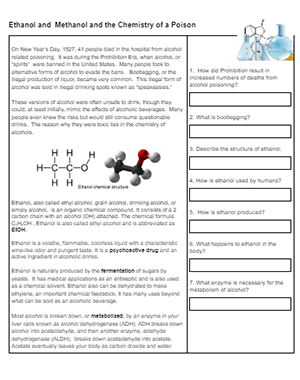
Most biology textbooks have opening chapters that review chemistry. I often tell my students that we need to learn a little bit of chemistry because really, organisms are just bags of chemicals. Advanced classes will need to understand some basics of chemistry: molecular bonds, pH scale, and water chemistry.
This article with questions compares two organic molecules, ethanol and methanol. Methanol is highly toxic to humans and animals. Ingestion or inhalation of methanol can cause severe health issues, including blindness, organ damage, and even death. Alternatively, ethanol, while not completely safe in large quantities, is far less toxic than methanol. It is the type of alcohol found in alcoholic beverages and is generally safe for consumption in moderation.
Methanol, also known as methyl alcohol, has the chemical formula CH3OH. It consists of a single carbon atom bonded to three hydrogen atoms and one hydroxyl (OH) group.
Ethanol, also known as ethyl alcohol, has the chemical formula C2H5OH. It contains two carbon atoms bonded to five hydrogen atoms and one hydroxyl (OH) group.
Ethanol is the main ingredient in alcohol beverages, created from the fermentation of grains and fruits. Methanol has a very similar chemical structure, with only one carbon in its backbone rather than the two found in ethanol. Both have an alcohol (OH) group attached.
During Prohibition, bootleggers often created a version of “spirits” from methanol by burning wood. Methanol is a poison! The result was that people drinking methanol would die or become blind as methanol was converted into a more toxic compound: formic acid. This process is known as toxification.
Students read the article that describes the compounds and their effects while answering related questions. A final section describes another type of poisoning from Lindol. Alcohol spiked with this compound could lead to paralysis, a condition called “Jake Leg” after the name of the alcohol that was toxic (Ginger Jake.)

Methanol as a Poison
Metabolic products: Methanol is toxic because of its metabolic products, which cause an accumulation of acid in the blood (metabolic acidosis), blindness, and death. When methanol is metabolized, it is converted into formaldehyde and then into formic acid, which is responsible for the toxic effects
Related Resources
Exploring the Chemistry of Adrenaline – compare the chemical structures of adrenaline, methamphetamine, and pseudoephedrine
Cell Signaling – Epinephrine – how epinephrine causes a signal cascade within the cell

